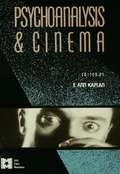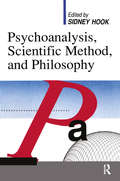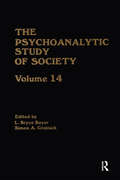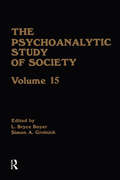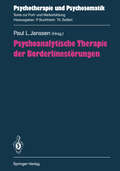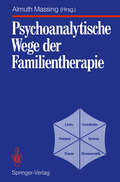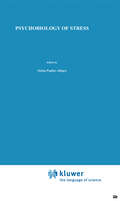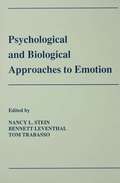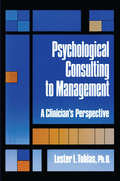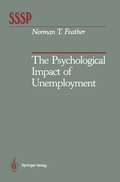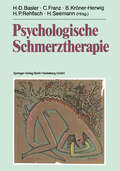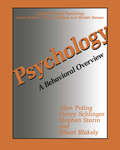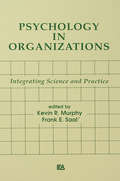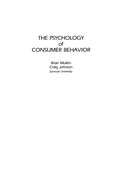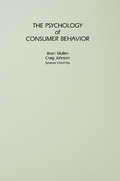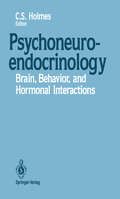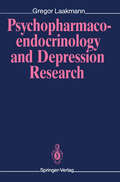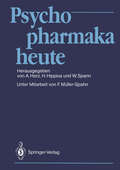- Table View
- List View
Psychoanalysis and Cinema (AFI Film Readers)
by E. Ann KaplanThese fifteen carefully chosen essays by well-known scholars demonstrate the vitality and variety of psychoanalytic film criticism, as well as the crucial role feminist theory has played in its development. Among the films discussed are Duel in the Sun, The Best Years of Our Lives, Three Faces of Eve, Tender is the Night, Pandora's Box, Secrets of the Soul, and the works of Jacques Tourneur (director of The Cat People and other features).
Psychoanalysis and Cinema (AFI Film Readers)
by E. Ann KaplanThese fifteen carefully chosen essays by well-known scholars demonstrate the vitality and variety of psychoanalytic film criticism, as well as the crucial role feminist theory has played in its development. Among the films discussed are Duel in the Sun, The Best Years of Our Lives, Three Faces of Eve, Tender is the Night, Pandora's Box, Secrets of the Soul, and the works of Jacques Tourneur (director of The Cat People and other features).
Psychoanalysis, Scientific Method and Philosophy: A Symposium (classic Reprint)
by Sydney HookThis by now well-known pioneering dialogue on Freudian analysis is concerned not with therapeutic implications, individual or social, of psychoanalysis or of any other brand of psychology, but solely with the status of psychoanalysis as a scientific theory. Matching talents with a distinguished group of philosophers and social scientists, psychoanalysts made their claims and willingly subject them to the methodological scrutiny common to the sciences and the philosophy of science. This book records one of the few times in the United States that a distinguished group of psychoanalysts met with an equally distinguished group of philosophers of science in a free, critical interchange of view on the scientific status of the field. While a sense of the event’s excitement is captured here, it also had clear results, such as an expanded notion of psychoanalysis as a scientific theory, and a clear realization that certain elements in psychoanalysis are substantially beyond the boundaries of causal inference or the rules of logic. Two opening statements by Heinz Hartmann and Ernest Nagel set the tone for the debate and discussion that followed. These are followed by social scientific statements of Abram Kardiner, Ernest van den Haag, and Alex Inkeles, followed by the philosophers Morris Lazerowitz, Donald C. Williams, and Anthony Flew. Such distinguished scholars as Adolf Grunbaum, Michael Scriven, Gail Kennedy, Arthur Pap, Philipp Frank. Arthur C. Danto, Max Black and others, round out this pioneering effort in the literature of intellectual combat. Sidney Hook applies to his vision of psychoanalysis the same compelling rigor he applied to other would-be advocates of a science beyond ordinary scientific method or safeguards. He nonetheless points out that even therapeutic success is not the last word, but must itself be tested on a variety of measures: statistical no less than analytical. This remains a courageous and disturbing work, one that commands attention among practicing psychiatrists, psychoanalysts—and their would-be patients.
Psychoanalysis, Scientific Method and Philosophy
by Sydney HookThis by now well-known pioneering dialogue on Freudian analysis is concerned not with therapeutic implications, individual or social, of psychoanalysis or of any other brand of psychology, but solely with the status of psychoanalysis as a scientific theory. Matching talents with a distinguished group of philosophers and social scientists, psychoanalysts made their claims and willingly subject them to the methodological scrutiny common to the sciences and the philosophy of science. This book records one of the few times in the United States that a distinguished group of psychoanalysts met with an equally distinguished group of philosophers of science in a free, critical interchange of view on the scientific status of the field. While a sense of the event’s excitement is captured here, it also had clear results, such as an expanded notion of psychoanalysis as a scientific theory, and a clear realization that certain elements in psychoanalysis are substantially beyond the boundaries of causal inference or the rules of logic. Two opening statements by Heinz Hartmann and Ernest Nagel set the tone for the debate and discussion that followed. These are followed by social scientific statements of Abram Kardiner, Ernest van den Haag, and Alex Inkeles, followed by the philosophers Morris Lazerowitz, Donald C. Williams, and Anthony Flew. Such distinguished scholars as Adolf Grunbaum, Michael Scriven, Gail Kennedy, Arthur Pap, Philipp Frank. Arthur C. Danto, Max Black and others, round out this pioneering effort in the literature of intellectual combat. Sidney Hook applies to his vision of psychoanalysis the same compelling rigor he applied to other would-be advocates of a science beyond ordinary scientific method or safeguards. He nonetheless points out that even therapeutic success is not the last word, but must itself be tested on a variety of measures: statistical no less than analytical. This remains a courageous and disturbing work, one that commands attention among practicing psychiatrists, psychoanalysts—and their would-be patients.
The Psychoanalytic Study of Society, V. 14: Essays in Honor of Paul Parin
by L. Bryce Boyer Simon A. GrolnickVolume 14 includes chapters on the psychoanalysis of political commitment (P. Parin); Jews and homosexuals as strangers (P. Parin); the analogous tasks of the psychoanalyst and the ethnographer (M. Gehrie); cultic elements in early Christianity (W. Meissner); Jewish apocalyptists (D. Merkur); creationist resistance to evolution (R. Graber & L. McWhorter); sacred objects and transitional phenomena in aboriginal Central Australia; and a review of the contributions of Paul Parin (D. Freeman).
The Psychoanalytic Study of Society, V. 14: Essays in Honor of Paul Parin
by L. Bryce Boyer Simon A. GrolnickVolume 14 includes chapters on the psychoanalysis of political commitment (P. Parin); Jews and homosexuals as strangers (P. Parin); the analogous tasks of the psychoanalyst and the ethnographer (M. Gehrie); cultic elements in early Christianity (W. Meissner); Jewish apocalyptists (D. Merkur); creationist resistance to evolution (R. Graber & L. McWhorter); sacred objects and transitional phenomena in aboriginal Central Australia; and a review of the contributions of Paul Parin (D. Freeman).
The Psychoanalytic Study of Society, V. 15: Essays in Honor of Melford E. Spiro
by L. Bryce Boyer Simon A. GrolnickVolume 15 features Melford Spiro's "Culture and Human Nature" and "The internalization of Burmese Gender Identity" along with an interview of Spiro by B. Kilbourne and S. Bolle. Additional topics include children's fantasy life in Papua New Guinea (F. Poole); a psychoanthropological approach to Kagwahiv food taboos (W. Kracke); an ethnological and Rorschach study of three groups of Australian aborigines (R. Boyer et al.); a consideration of the "trickster" in relation to issues of sublimation and psychosocial development; and a review of Bettelheim's contribution to anthropology (R. Paul).
The Psychoanalytic Study of Society, V. 15: Essays in Honor of Melford E. Spiro
by L. Bryce Boyer Simon A. GrolnickVolume 15 features Melford Spiro's "Culture and Human Nature" and "The internalization of Burmese Gender Identity" along with an interview of Spiro by B. Kilbourne and S. Bolle. Additional topics include children's fantasy life in Papua New Guinea (F. Poole); a psychoanthropological approach to Kagwahiv food taboos (W. Kracke); an ethnological and Rorschach study of three groups of Australian aborigines (R. Boyer et al.); a consideration of the "trickster" in relation to issues of sublimation and psychosocial development; and a review of Bettelheim's contribution to anthropology (R. Paul).
Psychoanalytische Therapie der Borderlinestörungen (Psychotherapie und Psychosomatik)
by P. Fürstenau U. Henneberg-Mönch S. O. Hoffmann M. Lohmer W. Schumacher R. Tölle W. TrimbornDie Beiträge dieses Bandes geben einen umfassenden Überblick über Möglichkeiten und Grenzen der Behandlung von Borderlinestörungen. Der Leser erhält Einblick in die diagnostischen und therapeutischen Probleme aus psychiatrischer und psychoanalytischer Sicht. Besonderer Schwerpunkt liegt auf der Darstellung der verschiedenen psychoanalytischen Behandlungsansätze bei Borderlinestörungen.
Psychoanalytische Wege der Familientherapie: System Familie, Supplement
by B. Bauers M. B. Buchholz R. Kreische A. Massing G. Reich I. SchöllDie psychoanalytische Familientherapie basiert auf einem Konfliktmodell, bei dem das Hauptgewicht auf der Erforschung und Veränderung der tiefliegenden, teils unbewußten Strukturen liegt, die zu den manifestierten Interaktionen, Mustern, Problemen und Symptomen einer Familie führten. Das Konzept der systemischen Familientherapie entwickelte sich bisher in eine ahistorische Richtung. Dabei wurde das Individuum, seine Geschichte und sein Erleben sowie das der Familien in ihrer historisch-biographischen und aktuell gesellschaftlichen Situation vernachlässigt. Im Gegensatz dazu reflektieren sämtliche Beiträge dieses Bandes die Schnittstellen zwischen individueller und übergreifender sozialer Dynamik. Zugleich werden in den einzelnen Beiträgen Ansätze aufgezeigt, die therapeutischen Möglichkeiten psychoanalytischer Familientherapie zu verfeinern und in Anwendungsfeldern - z.B. der Einzel- und Paartherapie - zu integrieren oder die Erkenntnisse innerhalb der familientherapeutischen Schulen zu verbreitern.
Psychobiology of Stress (NATO Science Series D: #54)
by AlbertoOliverio StefanPuglisi-AllegraFrom a historical point of view the first studies on the response of the organism to stressful situations in general, and on the psychobiology of stress in particular, are probably those of Cannon and de la Paz, the physiologists who showed in 1911 that the adrenal medulla and the sympathetic system are involved in emergency situations. Cannon noted that the venous blood of cats frightened by barking dogs contained adrenaline, a response of the organism which was prevented by adrenalectomy or by section of the splanchnic nerve innervating the adrenal medulla. Cannon suggested that the adrenal medulla was acting in concert with the sympathetic nervous system, so that both systems were activated during stress. The role of the sympathetic system in response to stressful events was later emphasized by the experiments carried out by Maickel et al. (1967) and by Mason (1968): these authors clearly showed that stressors activate the sympathetic system causing it to release adrenaline and noradrenaline. This line of research may be contrasted with that carried out by Hans Selye, centered on of the adrenal cortex in the stress response. Selye's findings and theories originated the role the so-called hypothalamic - pituitary - adrenal cortex (HPA) model of stress: in short, during stress adrenocorticotropic hormone is released from cells of the anterior pituitary and elicits secretion of glucocorticoids from the adrenal cortex.
Psychological and Biological Approaches To Emotion
by Nancy L. Stein Bennett Leventhal Tom TrabassoThe outgrowth of a University of Chicago conference on the psychological and biological bases of behavior, this unique collection of papers integrates the biological consideration of emotion with current psychological approaches. As such, it includes studies of the coping process associated with emotion as well as those that focus on the appraisal process giving rise to emotion. The book approaches emotion from cognitive, developmental, and biological systems and psychopathological perspectives. Theories on the cognitive, biological, and developmental bases for interpreting, representing, and reacting to emotional situations are proposed. In addition, new studies on issues and questions regarding the roles of cognition, language, brain lateralization, socialization, psychopathology, and coping with affect are presented.
Psychological and Biological Approaches To Emotion
by Nancy L. Stein Bennett Leventhal Thomas R. TrabassoThe outgrowth of a University of Chicago conference on the psychological and biological bases of behavior, this unique collection of papers integrates the biological consideration of emotion with current psychological approaches. As such, it includes studies of the coping process associated with emotion as well as those that focus on the appraisal process giving rise to emotion. The book approaches emotion from cognitive, developmental, and biological systems and psychopathological perspectives. Theories on the cognitive, biological, and developmental bases for interpreting, representing, and reacting to emotional situations are proposed. In addition, new studies on issues and questions regarding the roles of cognition, language, brain lateralization, socialization, psychopathology, and coping with affect are presented.
Psychological Consulting To Management: A Clinician's Perspective
by Lester L. TobiasFirst published in 1990. Routledge is an imprint of Taylor & Francis, an informa company.
Psychological Consulting To Management: A Clinician's Perspective
by Lester L. TobiasFirst published in 1990. Routledge is an imprint of Taylor & Francis, an informa company.
The Psychological Impact of Unemployment (Springer Series in Social Psychology)
by Norman T. FeatherThis book is concerned with the psychological effects of unemployment. In writing it I had two main aims: (1) to describe theoretical approaches that are relevant to understanding unemployment effects; and (2) to present the re sults of studies from a program of research with which I have been closely involved over recent years. In order to meet these aims I have organized the book into two main parts. I discuss background research and theoretical approaches in the first half of the book, beginning with research concerned with the psychological effects of unemployment during the Great Depression and continuing through to a dis cussion of more recent contributions. I have not attempted to review the liter ature in fine detail. Instead, I refer to some of the landmark studies and to the main theoretical ideas that have been developed. This discussion takes us through theoretical approaches that have emerged from the study of work, employment, and unemployment to a consideration of wider frameworks that can also be applied to further our understanding of unemployment effects.
Psychologische Schmerztherapie: Grundlagen, Diagnostik, Krankheitsbilder, Behandlung
by Heinz-Dieter Basler Carmen Franz Birgit Kröner-Herwig Hans P. Rehfisch Hanne SeemannPsychology: A Behavioral Overview (Nato Science Series B:)
by Alan Poling Henry Schlinger Stephen Starin Elbert BlakelyPsychology: A Behavioral Overview is an introductory text with an orienting per spective that is frankly behavioral rather than eclectic. This focus is made quite clear in the first chapter of the book, but in the remainder it also becomes clear that such a focus permits coverage of most of the topics found in the more common introductory text. Actually, the next five chapters (dealing with psy chology as a scienc~, methodology, evolution, physiology, and learning) are in many ways comparable to the treatments provided in more eclectic introductory texts. The behavioral focus and the departure from traditional approaches be come most significant in the last six chapters which deal with traditional psycho logical topics (e. g. , language, child development, and personality)-but deal with them systematically in terms of the concepts and principles introduced in the chapters on evolution and physiology, and especially in the chapter on learning. Using the concepts provided early in the text to interpret complex aspects of human behavior provides valuable justification for those concepts, as well as an opportunity for improved understanding of them. Although students will not make extensive contact with the variety of the oretical approaches found in the typical text, they will become especially compe tent in the use of behavioral concepts and principles to interpret and understand many of the topics of traditional importance in psychology.
Psychology in Organizations: integrating Science and Practice (Applied Psychology Series)
by Kevin R. Murphy Frank E. SaalThis book deals with two key questions. First, is there a firm scientific basis for the major applications of psychology in organizations? Second, does the practice of psychology in organizations contribute in any meaningful way to psychological research? This text attempts to answer these questions by describing some of the unique ways in which Industrial/Organizational (I/O) psychologists integrate science and practice in applying psychology in organizations. The editors of this volume believe that there is great potential for the effective interplay of science and practice in I/O psychology. Aware, however, that much work must still be done before a truly effective integration can be achieved and maintained, they have created a text that offers specific suggestions for improvement as well as many examples of successful integration. Psychology in Organizations explores the unique relationship between science and practice within industrial/organizational psychology. The contributors seek to answer two main questions: * Is there a firm scientific basis for the major applications of psychology in organizations? * Does the practice of psychology in organizations contribute in any meaningful way to psychological research? After an initial examination of the industrial/organizational psychologist as a scientist and practitioner, Psychology in Organizations looks at specific roles played in such issues as job performance and productivity, sexual harassment, drug abuse, and drug testing. A final chapter looks at both the past and future of the field and suggests future applications.
Psychology in Organizations: integrating Science and Practice (Applied Psychology Series)
by Kevin R. Murphy Frank E. SaalThis book deals with two key questions. First, is there a firm scientific basis for the major applications of psychology in organizations? Second, does the practice of psychology in organizations contribute in any meaningful way to psychological research? This text attempts to answer these questions by describing some of the unique ways in which Industrial/Organizational (I/O) psychologists integrate science and practice in applying psychology in organizations. The editors of this volume believe that there is great potential for the effective interplay of science and practice in I/O psychology. Aware, however, that much work must still be done before a truly effective integration can be achieved and maintained, they have created a text that offers specific suggestions for improvement as well as many examples of successful integration. Psychology in Organizations explores the unique relationship between science and practice within industrial/organizational psychology. The contributors seek to answer two main questions: * Is there a firm scientific basis for the major applications of psychology in organizations? * Does the practice of psychology in organizations contribute in any meaningful way to psychological research? After an initial examination of the industrial/organizational psychologist as a scientist and practitioner, Psychology in Organizations looks at specific roles played in such issues as job performance and productivity, sexual harassment, drug abuse, and drug testing. A final chapter looks at both the past and future of the field and suggests future applications.
The Psychology of Consumer Behavior
by Brian Mullen Craig JohnsonAfter years of study in the area of consumer behavior, Mullen and Johnson bring together a broad survey of small answers to a big question: "Why do consumers do what they do?" This book provides an expansive, accessible presentation of current psychological theory and research as it illuminates fundamental issues regarding the psychology of consumer behavior. The authors hypothesize that an improved understanding of consumer behavior could be employed to more successfully influence consumers' use of products, goods, and services. At the same time, an improved understanding of consumer behavior might be used to serve as an advocate for consumers in their interactions in the marketplace.
The Psychology of Consumer Behavior
by Brian Mullen Craig JohnsonAfter years of study in the area of consumer behavior, Mullen and Johnson bring together a broad survey of small answers to a big question: "Why do consumers do what they do?" This book provides an expansive, accessible presentation of current psychological theory and research as it illuminates fundamental issues regarding the psychology of consumer behavior. The authors hypothesize that an improved understanding of consumer behavior could be employed to more successfully influence consumers' use of products, goods, and services. At the same time, an improved understanding of consumer behavior might be used to serve as an advocate for consumers in their interactions in the marketplace.
Psychoneuroendocrinology: Brain, Behavior, and Hormonal Interactions
by Clarissa S. Holmesmore intuitive study to greater empiricism. Frequently, chapters are di vided into discrete sections to discuss each rather distinct era of inquiry. This approach, when used, can provide a valuable historical overview of the early clinical formulations about each disease. Even though many of the earlier research philosophies and techniques may seem so simplistic as to mitigate against their inclusion, early research hypotheses were often generated from astute observation of clinical findings and relationships. In addition to shaping later empirical questions, a review of historical ante cedents provides a yardstick by which to measure the progress of more current studies, even though much is yet to be learned. As is true of any refinement of knowledge, the juxtaposition of the two approaches of study reveals that some of the early postulations about patient attributes and disease consequences have been confirmed, while other suppositions have been discarded. Although the generally subjective assessment methods used in the early studies may not have provided an optimal data base, it is interesting to note which clinical impressions were able to withstand greater empirical rigor and which were not. The book at its inception was intended to provide a succinct introduc tion to psychoneuroendocrinology research for practitioners and scientists who might be relatively unfamiliar with the area. However, it quickly became apparent that the sophistication of the information could not be readily reduced without vast oversimplification and loss of substance.
Psychopharmacoendocrinology and Depression Research
by Gregor Laakmann1.1 Outline of the Study In this study the influence of psychotropic drugs on anterior pituitary hormone (APR) secretion was investigated in healthy subjects and in depressed patients. The basis for this study is formed by pharmacological investigations which indicate that the therapeutic effect of psychotropic drugs can be attributed to their functional influence on central nervous aminergic impulse transmission (stimuli) as well as by endocrinological investigations which show that central nervous aminergic neurons influence APR secretion in man. The purpose was to frod out if psychotropic drugs with differing pharmacological actions also influence APR secretion differently, even though the complex processes of central nervous stimuli transmission, the effect of psychotropic drugs on these processes, as well as the action of aminergic neuronal systems on APR secretion are not completely understood. Furthermore, it was investigated if it is possible to reach conclusions on the effects of drugs on central nervous aminergic neurons based upon APR secretion data. Specifically, the effects of various antidepressants, neuroleptics, and benzodiazepine-type tranquilizers on the secretion of growth hormone (GR), prolactin (PRL), adrenocorticotropic hormone (ACTR), and cortisol were investigated in healthy male subjects. The first part of this study presents in detail the results of these experiments and also incorporates the results of other investigators. It is endeavored to answer the question whether and to what extent the different psychotropic drugs influence APR secretion and whether the APR secretion profiles of the different psychotropic drugs can serve as a possible pharmacoendocrinological model in humans.
Psychopharmaka heute
by F. Müller-Spahn W. SpannDie Neurobiologie und die Pharmakotherapie verschiedener psychiatrischer Krankheitsbilder sind der Inhalt dieses Buches. Neue Aspekte sowohl in der Forschung als auch bei der Therapie werden dargestellt. Deshalb gehört dieses Buch in das Regal sowohl des Forschers als auch des verantwortungsbewußten Praktikers.
